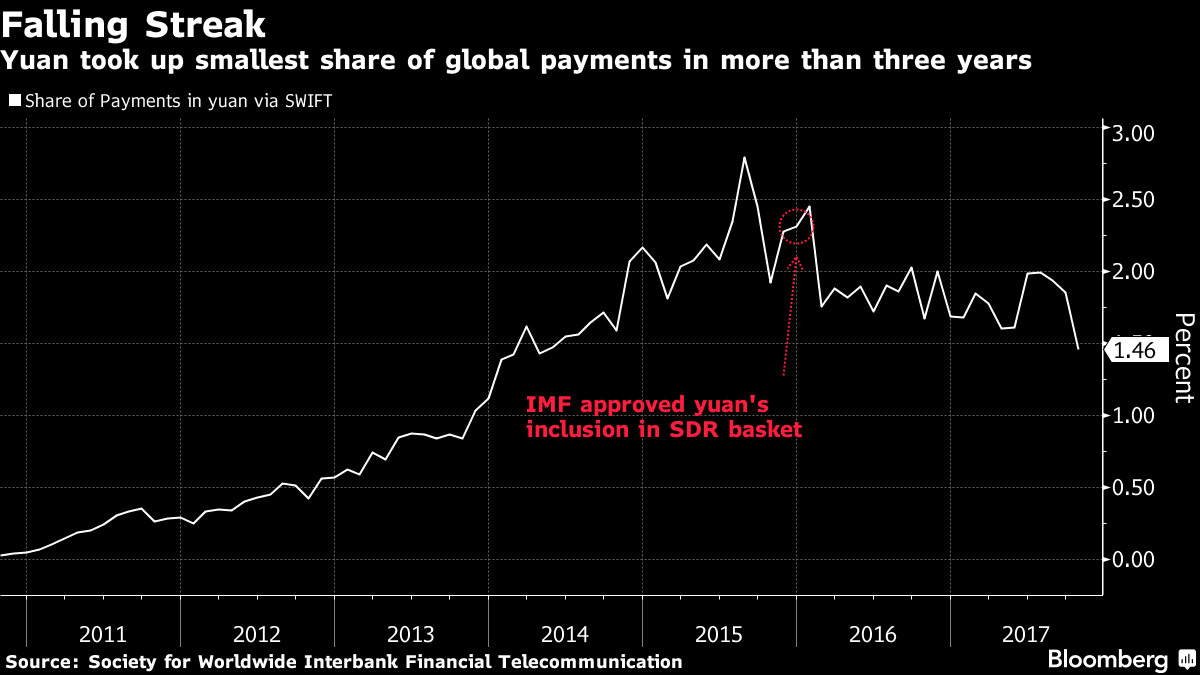China's moves to set up trading oil in yuan have sparked enthusiasm about what could be a shift in the global financial system: a reduced role for the U.S. dollar. Players like Adam Levinson, founder of hedge fund Graticule Asset Management Asia, call it a “huge story” to come.
But with policy makers prioritizing market stability over internationalization, plans laid back in 2012 to begin oil-futures trading priced in yuan or dollars in Shanghai that year are still pending. The latest from the city's International Energy Exchange: It's coming soon, with test trades scheduled this weekend.
“This contract has the potential to greatly help China's push for yuan internationalization,” said Yao Wei, chief China economist at Societe Generale SA in Paris. “But its success will hinge critically on the degree of freedom allowed for the capital flows related to the contract.”
As the world's largest energy consumer and an increasing source of investment capital for oil-producing nations, China has an interest in using its own currency rather than that of a geopolitical competitor. One hurdle for setting up a rival to Brent or West Texas Intermediate: Overseas oil producers and traders would need to swallow China's capital controls and penchant for occasional market interventions.
Similar hurdles have kept foreign investors as bit players in China's giant mainland stock and bond markets.
Chinese authorities have avoided the kind of big international push that accompanied their campaign to get the yuan into the International Monetary Fund's basket of official reserve currencies in 2015, suggesting ambitions for pricing commodities in yuan remain restrained for now. There was no mention of the petro-yuan in key National Development and Reform Commission documents following a pivotal October Communist Party leadership gathering.
The latest developments have been incremental. Shanghai's INE plans to conduct a drill to test trading, settlement and quote transmission of crude futures Dec. 9-10. No date was announced for the debut. Back when futures were proposed in 2012, it followed spikes in crude prices above $100 a barrel. Nowadays, oil is much less costly, at under $60 and averaging little more than $50 this year.
Saudi Hopes
The prospect of the Middle East embracing the petro-yuan has been stoked in part by speculation that Saudi Arabia could announce it will accept the yuan for some of its exports to China.
“The currency's influence in the region is set to grow in tandem with Xi's proactive and assertive foreign policy,” economists led by Chris Leung at the Singaporean bank DBS Group Holdings wrote in a report titled “China in 2018/19: The Age of the Strongman.” Xi's signature Belt and Road Initiative of developing ties across Eurasia “will be an indispensable catalyst for greater use of the yuan on oil settlement,” the team wrote.
Saudi Arabia's Energy Ministry and Saudi Aramco, its state-run oil company, declined to respond to requests for comment on being open to accepting yuan for payment. U.A.E. Energy Minister Suhail Al Mazrouei told reporters in Abu Dhabi Nov. 20 he didn't have enough background on the potential petro-yuan to comment on it.
One major challenge facing Middle East producers considering accepting a big share of their oil contracts in yuan would be the exchange-rate risk they would run, given that most of the region maintains currency pegs to the dollar.
Dollar 'Entrenched'
“The dollar is so entrenched that it's difficult to see that role diminishing,” said Shady Shaher, head of macro strategy at Dubai-based lender Emirates NBD PJSC. “It makes sense in the long-run to look at transactions in yuan, because China is a key market,” though it will take years to develop, he said.
Big Chinese participation in Aramco's planned initial public offering could help sway Saudi opinion toward accepting yuan, which is used in less than 1.5% of global payments measured by Swift. Yet the experience of Russia shows that even when leadership goals are aligned, yuan use can be slow to take off.
China once had oil-futures trading, in the mid-1990s, before abandoning the effort along with trading in bond futures, due to volatility. Concerns about destabilizing moves continue today, prompting intervention of one kind or another in markets from stocks to the yuan, which has unusually low fluctuations in daily trading relative to its counterparts.
“Chinese regulators have made it clear that they want stability in financial markets, including the new futures contracts to be listed” for oil, said Li Zhoulei, an analyst with Everbright Futures Co. in Shanghai. “”t remains to be seen how the crude contract can gain influence and at the same time avoid excessive volatility.”
Missteps in moves to embrace a more flexible yuan in 2015 prompted China to double down on controls since then, and there's no clear sign they'll be lifted anytime soon.
“It is not unreasonable to envision a world in which the overwhelming share of commodity contracts, especially for oil, are no longer denominated just in dollars,” said Eswar Prasad, a former China division chief at the IMF. But “the yuan's role in global finance will ultimately be determined by the degree of commitment of Xi Jinping's government to economic and financial market reforms.”

From: Bloomberg News
© 2025 ALM Global, LLC, All Rights Reserved. Request academic re-use from www.copyright.com. All other uses, submit a request to [email protected]. For more information visit Asset & Logo Licensing.




